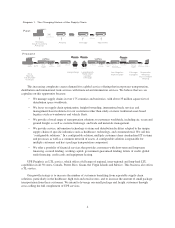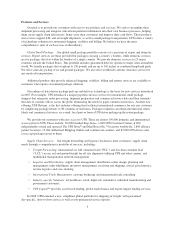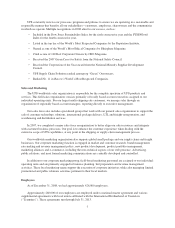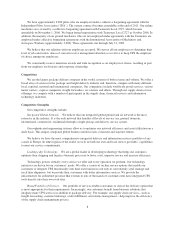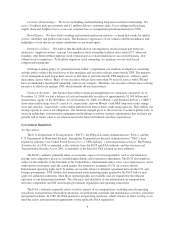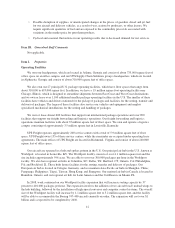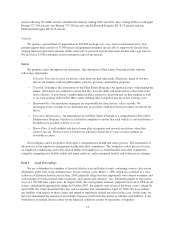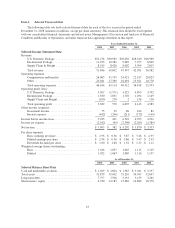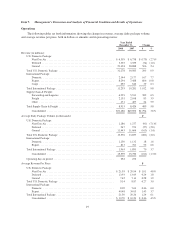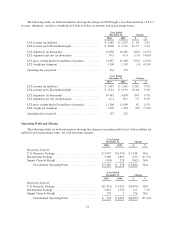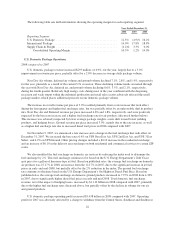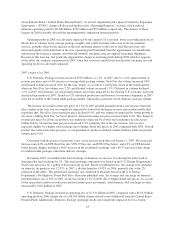UPS 2008 Annual Report Download - page 25
Download and view the complete annual report
Please find page 25 of the 2008 UPS annual report below. You can navigate through the pages in the report by either clicking on the pages listed below, or by using the keyword search tool below to find specific information within the annual report.and five Boeing 747-400F aircraft scheduled for delivery during 2009 and 2010. Also, during 2008 we sold eight
Boeing 727-100 aircraft, two Boeing 727-200 aircraft, one McDonnell-Douglas DC-8-71 aircraft and one
McDonnell-Douglas DC-8-73 aircraft.
Vehicles
We operate a ground fleet of approximately 107,000 package cars, vans, tractors and motorcycles. Our
ground support fleet consists of 31,000 pieces of equipment designed specifically to support our aircraft fleet,
ranging from non-powered container dollies and racks to powered aircraft main deck loaders and cargo tractors.
We also have 37,000 containers used to transport cargo in our aircraft.
Safety
We promote safety throughout our operations. Our Automotive Fleet Safety Program is built with the
following components:
•Selection. Five out of every six drivers come from our part-time ranks. Therefore, many of our new
drivers are familiar with our philosophies, policies, practices and training programs.
•Training. Training is the cornerstone of our Fleet Safety Program. Our approach starts with training the
trainer. All trainers are certified to ensure that they have the skills and motivation to effectively train
novice drivers. A new driver’s employment includes extensive classroom and on-line training as well
as on-road training, followed by three safety training rides integrated into his or her training cycle.
•Responsibility. Our operations managers are responsible for their drivers’ safety records. We
investigate every accident. If we determine that an accident could have been prevented, we retrain the
driver.
•Preventive Maintenance. An integral part of our Fleet Safety Program is a comprehensive Preventive
Maintenance Program. Our fleet is tracked by computer to ensure that each vehicle is serviced before a
breakdown or accident is likely to occur.
•Honor Plan. A well-defined safe driver honor plan recognizes and rewards our drivers when they
achieve success. We have over 4,450 drivers who have driven for 25 years or more without an
avoidable accident.
Our workplace safety program is built upon a comprehensive health and safety process. The foundation of
this process is our employee-management health and safety committees. The workplace safety process focuses
on employee conditioning and safety-related habits. Our employee co-chaired health and safety committees
complete comprehensive facility audits and injury analyses, and recommend facility and work process changes.
Item 3. Legal Proceedings
We are a defendant in a number of lawsuits filed in state and federal courts containing various class-action
allegations under state wage-and-hour laws. In one of these cases, Marlo v. UPS, which was certified as a class
action in a California federal court in June 2004, plaintiffs allege that they improperly were denied overtime, and
seek penalties for missed meal and rest periods, and interest and attorneys’ fees. Plaintiffs purport to represent a
class of 1,300 full-time supervisors. In August 2005, the court granted summary judgment in favor of UPS on all
claims, and plaintiff appealed the ruling. In October 2007, the appeals court reversed the lower court’s ruling. In
April 2008, the Court decertified the class and vacated the trial scheduled for April 29, 2008. We have denied
any liability with respect to these claims and intend to vigorously defend ourselves in this case. At this time, we
have not determined the amount of any liability that may result from this matter or whether such liability, if any,
would have a material adverse effect on our financial condition, results of operations, or liquidity.
14


